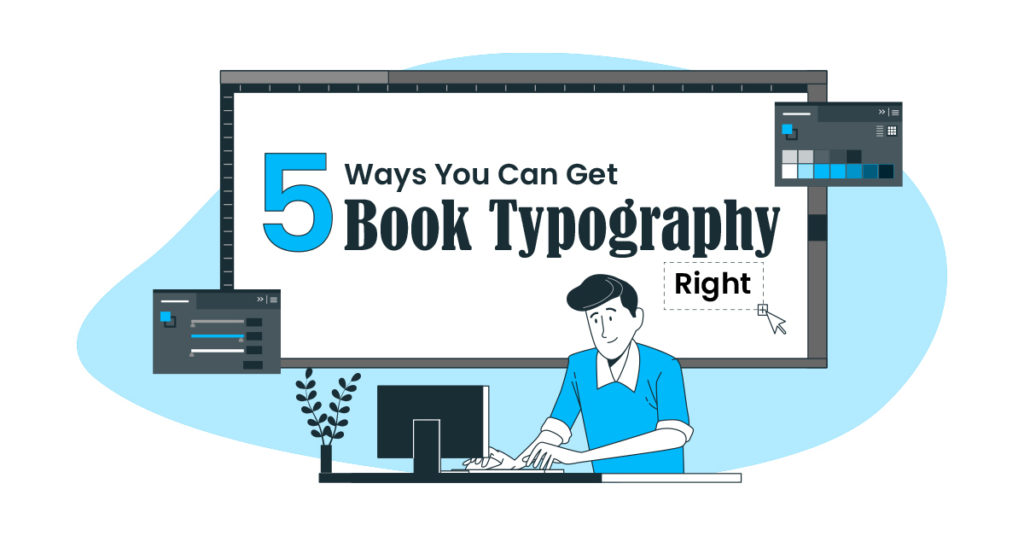5 Ways You Can Get Book Typography Right

Typography is the art of organising and presenting text in a legible and aesthetically pleasing fashion. You may have noticed typography at work everywhere- from the lettering on a movie poster to the flourishes on a bottle of Coke. Books are no exception, and book typography in books includes more than just the text on the front cover and mere font selection. It is concerned with arranging text in a legible and visually pleasing fashion so your book can be both readable and memorable. If you’re looking to publish your next book, you might want to pay attention to this key element of your book. To help you out, we’ve laid out five typography rules that you can follow while preparing your book for success-
- Choose clear typography so readers can access your story
The most important part of any volume is the text itself. One of the paramount aspects of typography is its function: making the text easier to read. When the type is clear and consistent, readers can escape into the words of the story. On the other hand, illegible typography diverts attention away from the writing, and toward the text’s arrangement on the page. Thus, in all circumstances, avoid using a typeface that doesn’t pass the basic test of legibility- think Monotype Corsiva in books. Because then your readers are squinting at the page, using all their attention to decipher your words instead of enjoying them. What’s worse, they may be too annoyed with your choice of font to pursue the task of reading the text very diligently. In both cases, odds are they’ll stop reading long before the book is done. Thus, play it safe and use a clean, legible font.
- Choose attractive typography for the cover
When it comes to your book’s cover, you want to draw readers’ eyes. This is an area where you need not be afraid to let bold and beautiful typography shine. For books jostling for attention in overflowing bookshelves or marketplaces like Amazon, an eye-catching title can help attract readers. It is important to know how crucial typography is to a beautiful, compelling cover. To choose the right typeface for a book cover, you need to think beyond mere beauty. In addition to visual appeal, all the text on a cover needs to be readable and appealing at thumbnail size. Even the most gorgeous font won’t cut it if it’s illegible or confusing at thumbnail dimensions. In addition to this, the typography you choose for your cover must be genre-appropriate. Your cover’s typography must not be suggestive of, say, science fiction when the book is a contemporary romance.
- Remember that your chosen typography will distil your brand image
Typography is particularly useful for signalling that a number of books belong to the same series or are written by the same author. A cover with appealing typography can do more than pique readers’ interest at a glance. It can also create a powerful impression that will make your book memorable. Soon, they will come to associate these visual keys with your brand image as an author. Thus, it is important to adorn a cover with a memorable type that perfectly encapsulates the feel of the story. A proof of this branding power lies in R.L. Stine’s Goosebumps series. What comes to mind is the distinct, drippy typeface splashed across its covers. The font is appropriate for the series’ genre and is still child-friendly.
- Go with professional typography to make a lasting impression
It’s simple- using professional typography makes books seem worth the money to readers. To make the powerful impression of professionalism, it’s best to leave designing to the pros. To potential readers, a book’s design, typography included, conveys the time and care the author put into making a quality product. If they see a lazy Times New Roman title on a cover, or leaf through a book’s pages to encounter Comic Sans, it may give the impression that the author cut corners everywhere, including in the writing. That’s where professional typographers step in with their artistic vision, design chops, and publishing experience.
- Pay close attention to your book interior’s typography
Be sure to check your book’s interior for readable, professional-looking text. Use appropriate typefaces that adhere to the conventions of the genres. Do some research and flip through published books in the same niche to find out what kind of typefaces predominate. It is also important to distinguish between typefaces for print books and typefaces for eBooks. Make sure that the text is easily readable for longer spans of time. If you’re writing an eBook, try to preview your text in its published form, whether that’s an epub or Mobi file. Your computer screen can be deceiving, and you need to make sure the typeface you chose translates well to the book’s final form.
Typography is an important aspect of the book’s presentation. It plays a crucial role in making a book look polished. As an author, we advise you to invest some time and energy in getting it right. By doing so, you’ll give readers an enjoyable experience, hopefully turning them into lifelong fans of your books!


